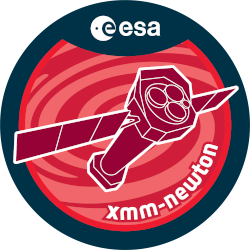

| Proposal ID | 084418 |
| Title | Detection of Extended Gas Perpendicular to Cluster Merger Axes |
| Download Data Associated to the proposal | https://nxsa.esac.esa.int/nxsa-sl/servlet/data-action-aio?obsno=0844180101 |
| DOI | https://doi.org/10.5270/esa-gutlbsj |
| Principal Investigator, PI | Prof Nobuhiro Okabe |
| Abstract | We define, based on optical galaxy distributions, an unbiased sample of mergingclusters to compile various merger phases. The ROSAT image stacked over cluster-subcluster pairs shows that the X-ray emitting gas in the central region iselongated along the merger axis, however, outside the core it is extended alongits perpendicular direction. It implies that the gas halo is pushed outwardsperpendicular to the merger axis by colliding two gas cores. XMM-Newtonsnapshots of the clusters enable us to identify cluster merger phases andprovide a robust evidence of the gas extended perpendicular to the merger axis,for the first time. Furthermore,we measure X-ray temperature and luminositywithin r500, in order to quantify merger boost by comparing with weak-lensing masses. |
| Publications |
|
| Instrument | EMOS1, EMOS2, EPN, OM, RGS1, RGS2 |
| Temporal Coverage | 2019-08-06T23:49:43Z/2019-08-10T11:02:43Z |
| Version | 17.56_20190403_1200 |
| Mission Description | The European Space Agencys (ESA) X-ray Multi-Mirror Mission (XMM-Newton) was launched by an Ariane 504 on December 10th 1999. XMM-Newton is ESAs second cornerstone of the Horizon 2000 Science Programme. It carries 3 high throughput X-ray telescopes with an unprecedented effective area, and an optical monitor, the first flown on a X-ray observatory. The large collecting area and ability to make long uninterrupted exposures provide highly sensitive observations. Since Earths atmosphere blocks out all X-rays, only a telescope in space can detect and study celestial X-ray sources. The XMM-Newton mission is helping scientists to solve a number of cosmic mysteries, ranging from the enigmatic black holes to the origins of the Universe itself. Observing time on XMM-Newton is being made available to the scientific community, applying for observational periods on a competitive basis. |
| Creator Contact | https://www.cosmos.esa.int/web/xmm-newton/xmm-newton-helpdesk |
| Date Published | 2020-09-02T22:00:00Z |
| Last Update | 2025-08-04 |
| Keywords | "cluster merger phases", "perpendicular direction", "cluster merger axes", "central region", "quantify merger boost", "cluster subcluster pairs", "XMM", "merger axis", "colliding gas cores", "merger phases", "robust evidence", "pushed outwards perpendicular", "xray emitting gas", "xmm newton snapshots", "rosat image stacked", "gas halo", "gas perpendicular", "weak lensing masses", "optical galaxy distributions", "xray temperature", "XMM-Newton", "merging cluster", "unbiased sample", "ROSAT" |
| Publisher And Registrant | European Space Agency |
| Credit Guidelines | European Space Agency, Prof Nobuhiro Okabe, 2020, 'Detection of Extended Gas Perpendicular to Cluster Merger Axes', 17.56_20190403_1200, European Space Agency, https://doi.org/10.5270/esa-gutlbsj |